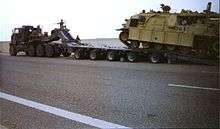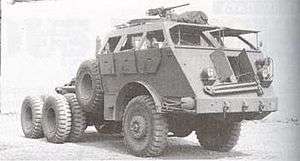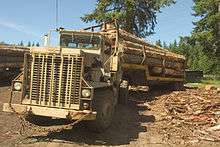Heavy Equipment Transport System

Heavy Equipment Transport System (abbreviated as HETS) is a term applied (primarily) to a U.S. Army logistics vehicle transport system, the primary purpose of which is to transport the M1 Abrams tank. It is also used to transport, deploy, and evacuate armored personnel carriers, self-propelled artillery, armored bulldozers and other heavy vehicles and equipment of all types.
The current U.S. Army vehicle used in this role is an Oshkosh-built M1070 tractor unit in A0 and A1 configurations which is coupled to a DRS Technologies M1000 semi-trailer.[1] This combination replaced the earlier Oshkosh-built M911 tractor unit and M747 semi-trailer.
The M1070 and M1000

To meet a US Army requirement for the transport of the M1A1 Abrams main battle tank (MBT) Oshkosh Truck Corporation (now Oshkosh Defense) proposed the M1070. A contract for 1044 M1070 was placed, with production commencing in July 1992.[2] The final U.S. Army contract for the original A0 version called for 195 vehicles. These were delivered between March 2001 and March 2003. U.S. Army deliveries of A0 versions totalled 2,488.[2] Following extensive use, some M1070 have been Reset to original build standard by Oshkosh.[2]
The M1070E1 model was developed in the mid-1990s in conjunction with the U.S. Army as a possible Technology Insertion Programme (TIP) for the M1070. No orders were placed.[2]
In March 2008 Oshkosh Defense announced the award of a contract from the U.S. Army to begin engineering and initial production of the next-generation of HET.[2] Oshkosh announced in October 2010 its first delivery order for the M1070A1 HET. Production of the M1070A1 concluded in August 2014, with new vehicle production totalling 1,591.[2]
The trailer used with the M1070A0 and M1070A1 is the M1000.[3] The M1000 was originally developed as a private venture by Southwest Mobile Systems (later Systems & Electronics Inc (SEI), now DRS Technologies) as a response to a possible US Army requirement for transporting M1 and M1A1 MBTs. A production order for 1,066 M1000 units was placed by the U.S. Army in 1989. By July 2009 more than 2600 M1000 trailers had been ordered.[2]
- The M1070 and M1000 are both air-transportable by C-5 Galaxy or C-17 Globemaster III aircraft.
- The M1070 replaced the Scammell Commander as the British Army heavy tank transporter in 2001. The UK version (M1070F) is compliant with European legislation on emissions (EURO III).
Previous Heavy Equipment Transports
M25 Tank Transporter
| M25 Tank Transporter | |
|---|---|
 M26 tractor | |
| Place of origin | United States |
| Service history | |
| In service | 1941-1955 |
| Wars | World War II |
| Production history | |
| Designer | Knuckey Truck Company |
| Manufacturer | Pacific Car & Foundry Co. |
| Specifications | |
| Weight | 22 tons |
| Length | 7.7 m |
| Width | 3.3 m |
| Height | 3.2 m |
| Crew | 7 |
|
| |
| Armor |
front 3/4 inch sides, rear 1/4 inch |
Main armament | .50 cal M2 machine gun |
| Engine |
Type 440 6-cylinder gasoline engine 240 hp |
| Suspension | 6×6 |
Operational range | 400 km |
| Speed | 26 mph (42 km/h) |
The M25 Tank Transporter was a heavy tank transporter and tank recovery vehicle used in World War II and beyond by the US Army.
Nicknamed the Dragon Wagon, the M25 was composed of a 6×6 armored tractor (M26) and 40-ton trailer (M15).
Development
In 1942 a new 40-ton semi-trailer tank transporter was required. This was to offer better off-road performance than the M9 24-small-wheel trailer, and greater capacity than the 30-ton 8-large-wheel Shelvoke and Drewry semi-trailers, then in use with the Diamond T tractor unit. This new trailer was designed by the Fruehauf Trailer Company (based in Detroit, MI).[4] A new tractor unit was required, as this heavier trailer was more than the Diamond T could cope with.
The M26 tractor was designed by the San Francisco-based Knuckey Truck Company. When Knuckey's production capacity proved insufficient the Army awarded production to the Pacific Car & Foundry Co. of Seattle, Washington.
Designated TR-1 by Pacific Car, the 12-ton 6×6 M26 tractor was powered by a Type 440 240 bhp 6-cylinder gasoline engine developed exclusively for it by Hall-Scott (although also used to uprate the Diamond T). Some 2,100 Type 440s were built. Baxter[4] notes "over 1,300" M26 and M26A1 being built.
Unusually, the tractor unit was fitted with both an armored cab and two winches with a combined pull of 60 tons.[4] The intention was that as well as hauling the tank transporter semi-trailer, the tractor unit could itself be used for battlefield light recovery work.
A later unarmored version of the M26 tractor was designated the M26A1. An experimental ballast tractor conversion was experimented with by the British Fighting Vehicle Proving Establishment (FVPE)[4]
 M26 tractor.
M26 tractor.- M26A1 tractor.
- Rearwheel drive by chains.
Service
The M26 tank was the first to enter service with the US Army in Europe in 1944-45.[5]
U.S. Nomenclature
In the nomenclature system used by the U.S. Army Ordnance Corps Supply Catalog this vehicle is referred as the G160.
Specifications
M746/M747 - M911/M747


Prior to 1993, the U.S. Army employed the Commercial Heavy Equipment Transporter (C-HET), which consisted of either the M746 or the M911 truck tractor and the M747 semitrailer.
- The M746 was an 8×8 22 1/2-ton tractor built by Ward LaFrance from 1975 to 1977. Approximately 125-185 were built.
- The lift axle 8×6 Oshkosh M911 superseded the M746 after 1977.[8]
During Operations Desert Shield and Desert Storm the M911 vehicles were employed primarily to haul M1 Abrams tanks. However, they demonstrated poor durability when loads exceeded 60 tons. Some are still serving as heavy transports of other military equipment, such as cargo handling equipment.
General Characteristics
| M911 tractor | M746 tractor | M747 trailer | |
|---|---|---|---|
| Length: | 30 feet | 27 feet | 48.2 feet |
| Width: | 9.5 feet | 10 feet | 11.5 feet |
| Height: | 11.8 feet | 10 feet | 6.8 feet |
| Weight: | 26.3 tons | 25.8 tons | 17.1 tons |
| Speed: | 43 miles per hour | 38 miles per hour | N/A |
| Range: | 614 miles | 200 miles | N/A |
| Crew: | 2 | 2 | N/A |
| Engine: | 430 hp Detroit Diesel Series 92 (8V92TA) | 12 cyl Detroit Diesel 12V71T, 600 bhp @ 2500 rpm | |
| Transmission: | 5-speed automatic | N/A |
Operators












See also
External links
| Wikimedia Commons has media related to Oshkosh Corporation. |
References
- ↑ "Heavy Equipment Transporter System (HETS)". United States Army Acquisition Support Center. October 15, 2005. Retrieved August 8, 2017.
- 1 2 3 4 5 6 7 "Oshkosh M1070 and M1070A1 (8 × 8) Heavy Equipment Transporters (HETs) and M1000 semi-trailer". IHS Jane's Shaun C Connors & Christopher F Foss. 2015-08-27. Retrieved 2015-09-22.
- ↑ "TECHNICAL MANUAL OPERATOR'S MANUAL FOR TRUCK, TRACTOR, 8X8 M1070 A1 NSN 2320-01-564-6882". US Army. Retrieved 2015-09-28.
- 1 2 3 4 Baxter, Brian S. (1989). Breakdown: A History of Recovery Vehicles in the British Army. HMSO, for REME Museum. p. 51. ISBN 0-11-290456-4.
- ↑ "World War II: M26 Pershing". Thought Co. 2016. Retrieved August 8, 2017.
- ↑ "World War II: M26 Pershing". Thought Co. 2016. Retrieved August 8, 2017.
- ↑ "World War II: M26 Pershing". Thought Co. 2016. Retrieved August 8, 2017.
- ↑ "Fort Snelling Military Museum". Archived from the original on 2006-09-21. Retrieved 2006-11-15.